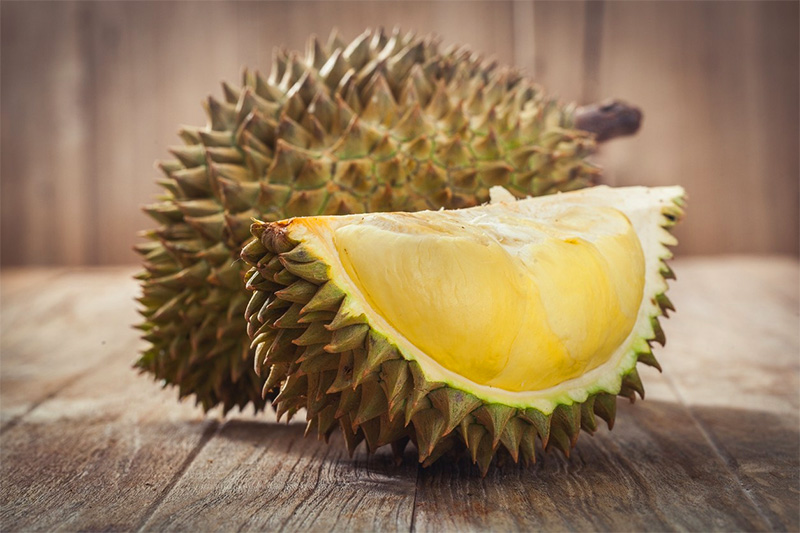Served ready-to-eat by street vendors, as palate-cleansing plates at restaurants and with a kaleidoscope of colorful arrays at local markets, the tropical fruits of Thailand are temptingly tasty. Eating fruit is a way of life for Thais and a big part of their everyday culinary culture. Here are 12 must-try tropical fruits for your Thai vacation.
1. Durian

To those who can stand its powerful smell, Durian is one sweet treat. Image: kaodim.com
Connoisseurs of Thailand’s ‘King of Fruits’ treat picking out the best durian as almost like an art-form. The process involves tapping the heavy and sharp, thorn-covered rind to discover when the world’s stinkiest fruit is best to eat. Banned from taxis and most public spaces, durian has a taste akin to natural gas mixed with a rotting odor which inspires a love-it-or-hate-it response. From soft and sweet to a harder flesh that’s oily and nutty, there’s nothing quite like it. High in ‘good’ fats’, it is perfect served with hot coconut milk and sticky rice. However, drinking a lot of alcohol with durian isn’t recommended as this can overload the body, digesting too much sugar and fat at the same time.
2. Mangosteen

Mangosteen – dubbed “the queen of fruits”. Image: healthline.com
If durian is the King of the fruit family, then mangosteen is the ‘Queen of Fruits’. Research into its anti-cancer potential is ongoing, while the benefits to the skin, anti-inflammatory, and anti-oxidant properties are widely known. The opaque and sometimes translucent flesh looks a little strange, but the taste varies from wonderfully sweet to lemony sour. The easiest way to eat mangosteen is to twist the top and bottom halves in different directions so the rind comes away clean from the upper half, leaving the soft fruit intact still in the lower half.
3. Mango

Flower-like mango cuts are done by making criss-cross slices and pushing the peel inwards. Image: wallhere.com
Mango is one of the most versatile and must-try, and try-again, fruits of Thailand. Soft and orange-colored, sweet mango is wonderful with sticky rice, coconut cream sauce, and a sprinkling of crispy cracked mung beans on top. Greener, harder mango has an incredibly sour taste and is great dipped in sugar and chili or a fermented fish dipping sauce!
4. Rambutan

Taking out the hairy rind reveals the Rambutan’s smooth and tender inner part. Image: parade.com
There’s something fun and almost other-worldly about the look of Thailand’s vibrantly colored rambutan with its distinct red and green hairy peel. Break through this soft exterior easily to reveal a white-translucent fruit that is unbelievably moreish. Rich in copper, the sweet-tasting flesh contains manganese, phosphorus, and potassium as well as iron, zinc, and magnesium.
5. Pomelo

The green pomelo fruit is actually pulpy pink on the inside. Image: Navintar on shutterstock.
Looking like a giant grapefruit, the taste of pomelo is similar yet far less bitter, with each succulent slice popping with juice with each bite. The peel is thick and so pomelo is often displayed already segmented with fruit either a pale yellow or a more orange-red color. Renowned for being rich in potassium, this thirst-quencher is a good source of magnesium, fiber, vitamin B6, and is a great immune-booster.
6. Guava

Fully-ripe, guavas are usually pink and soft though many prefer them when they are white and crunchy. Image: organicfacts.net
Hard and crunchy, the guava is perfect for those who like fruit that you can really bite into. Despite the lack of juice, it’s surprisingly hydrating. The flesh can be white with a hint of green or pinkish, with softer pulp and seeds at its core. Guava has to be eaten fresh soon after it’s cut open, otherwise, it soon begins to soften. The name in Thai is ‘farang’ which is the same name given to Westerners, primarily because it was introduced into Thailand from Europe originally. High in dietary fiber, studies suggest guava could have a positive impact on lowering blood glucose levels. It’s also rich in iron and in vitamin C, more so than citrus fruits. The fruit and leaves are used in traditional medicines in Southeast Asia to ward off coughs and colds.
7. Custard Apple

A custard apple split in half, showing the delicious white inner part. Image from It’s Lynny Kansas
As the name suggests, the custard apple tastes like a fruity dessert with a vanilla flavor too. The bumpy exterior almost looks like an artichoke, yet inside the flesh is soft and sweet. Rich in vitamins C, A, and B6, the fruit is a good source of potassium, iron, magnesium. Custard apple also contains zero fat and cholesterol. With lots of seeds, which shouldn’t be eaten, the creamy insides can be eaten with a spoon.
8. Young Coconut

Young coconut flesh can be easily scooped out with a spoon. Image: cellcode.us
Whether lounging by the infinity pool, looking out to the blue sea from a sun lounger or walking around exploring street markets and tourist attractions, there’s nothing quite so refreshing as a freshly-opened coconut. Forget hairy coconuts with thick, hairy flesh, the young coconut has a green and white shell and after the juice has been drunk the silky coconut can be easily scooped out and eaten with a spoon.
9. Rose Apple

Seen hanging from a tree, it is easy to understand how the rose apple got its name. Image: amazon.in
Looking like a fruit from a fairytale, the rose apple has the appearance of a waxy pear and can vary in color from light green to pink and a darker red. The skin is eaten along with the crisp fruit which does taste of a mix between an apple, watermelon, and roses! The watery taste makes the rose apple exceedingly thirst-quenching, while the fruit is high in fiber and is known to aid better digestion.
10. Lychee

In addition to its amazing flavor, the lychee is also quite easy to peel. Image: healthline.com
Much like the rambutan, the lychee is deliciously sweet with translucent flesh. A rich source of vitamins, the hard, red, and bumpy outer rind is actually quite thin and can be easily broken away so that the fruit inside remains as a ball of juicy tropical taste. The best way to eat lychees is to eat the fruit inside whole and spit out the brown seed in the middle.
11. Longgan

The longgan’s smooth translucent flesh is a delight -just make sure you dont swallow the seed! Image: p80naturalessence.com
Usually sold still attached to thin branches, peeling off the thin skin on the longan can be trickier than with other fruits with a thicker rind. However, the sweet, sometimes musky taste is divine, even if eating the white flesh with a black seed in the middle resembles an eyeball!
12. Jack Fruit

Once opened, the enormous and prickly jackfruit can be broken down into chewy plugs. Image: chowhound.com
The largest tree-fruit in the world, the almost meaty-looking texture makes the jackfruit versatile. It can be used in curries and savory dishes, while the subtle taste becomes sweetly tropical the riper it is. High in vitamins and minerals, the seeds are edible and highly nutritious too.
Tropical fruits are just part of the many culinary experiences you can have when in Thailand. Check out our article about why Thai cuisine is an international favorite.
Featured image by Tatiana Grozetskaya on Shutterstock
credit by Nadia Willan

